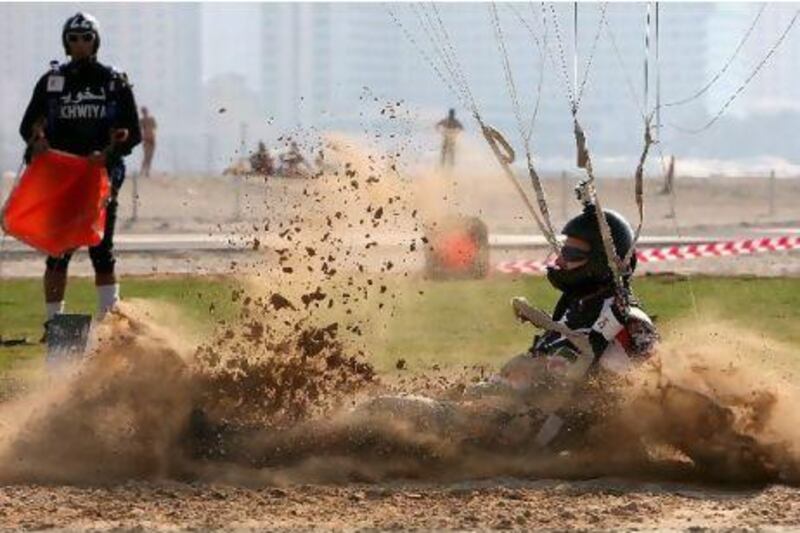DUBAI // Hundreds of people fell from the sky yesterday as the emirate's second International Parachuting Competition got off to a flying start.
With 500 entrants from 43 countries taking part, the contest was the broadest effort yet to make the emirate a landing point for skydivers around the world.
The 10-day event drew world-record holders and other top parachutists, or skydivers. Its main selling points included a generous US$320,000 (Dh1.2m) in prize money, the gentle winds off the Gulf that make for ideal parachuting conditions and the view of the Palm Jumeirah.
"It's not easy to concentrate because it's so beautiful," said Deborah Plat, 28, a commando in the French Air Force, who has competed worldwide for the French military team since 2001. She holds the women's world record for accuracy landing, which requires parachutists to land from 4,000 feet onto a bull's-eye the size of a CD.
"The conditions are not very difficult here," she said, rolling up her parachute outside the French tent on a grassy field. In the clear sky above, colourful parachutes wended their way down like drifting jellyfish.
Another draw for the competition are the two acrobatic air shows led by the well-known Hungarian pilot Zoltan Veres. His team performed at the opening ceremony last night and will appear again on January 14.
The push for a parachuting competition came when skydivers from the Emirati team found themselves constantly travelling abroad for their sport, explained Yousif Hassan al Hammadi, the head of the competition's organising committee and president of the Emirates Aviation Association.
It and other national teams will compete in two of three events, accuracy landing and formation skydiving.
In the latter, four parachutists drop from 10,000 feet and carry out a series of set poses while a fifth teammate films footage from above for judges to watch later. For the minute they perform their stunts, good teams can hit up to 30 poses.
The third individual event, canopy piloting, will have the biggest crowd appeal. As skydivers near the ground, they jerk their parachute strings to veer and rebuild so much speed they almost go back into freefall. But instead of crashing into the ground they zoom across a narrow marked path just inches in the air.
They will do several rounds, judged separately for how fast they can cross the path, how long they can go without touching the ground, and how close they can come to landing at a designated spot.
In a new category this year, they will also be invited to perform stunts across the path - some have zoomed across lying belly down, others might twist and turn several times before stopping.
"I hope they surprise us with new manoeuvres," said Barbara Holzer, a member of the organising committee.
Over the past year, Dubai has opened a new skydiving centre, or "drop zone", a skydiving school, and a skydiving team led by Sheikh Hamdan bin Mohammed, the Crown Prince of Dubai, who recently joined the sport.
The drop zone, which sits next to Jumeirah Beach Walk and is hosting the competition, has five helicopters and planes to escort professional skydivers and first-timers year-round.
"I like being in the air, the freefall," said Muhammad Nadeem, 30, from Pakistan, who began taking lessons a month ago and came to watch the canopy skydiving. "I love to see the ground coming so fast and at the last minute, you pull the string and you fly," said Marat Leiras, from Brazil, who won second place in canopy parachuting at last year's competition before being recruited to join the new UAE team.
Since resettling in Dubai a year ago, he has parachuted 800 times.
"It's love," he said. "The best skydive in my life will be the next one."
The three categories in the competition:
Formation skydiving
This is the most famous type of parachuting. Teams of four drop from 10,000 feet and, within a minute, rearrange themselves in a series of poses: they face each other, turn around, line up. A cameraman above shoots footage that is later evaluated by judges.
Accuracy landing
This is the most traditional form. Individuals start at about 4,000 feet and, over the next several minutes, carefully wind their way down towards a tiny target. For the best parachutists, landing even three centimetres away is too far off.
Canopy piloting
This is the newest and coolest category. As they near the ground, competitors take a sharp turn to regather speed and zoom across a long marked path just inches from the ground. They compete in separate rounds for speed (up to 120kph), distance (up to 180 metres before hitting the ground) and accuracy (where they must touch the ground at a certain spot). This year they will also compete in a new round called “freestyle”, where they can show off their stunts, such as crossing the path backwards or doing a few turns before stopping.
A conversion in this story has been corrected since its original publication. US$320,000 is Dh1.2 million; rather than the US$320,000 (Dh118,000) that was originally published.






